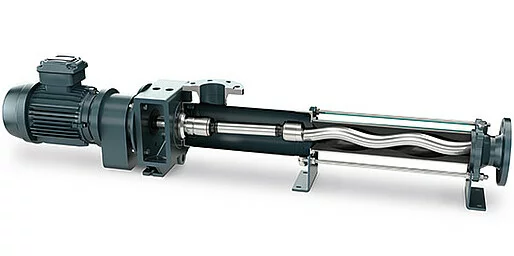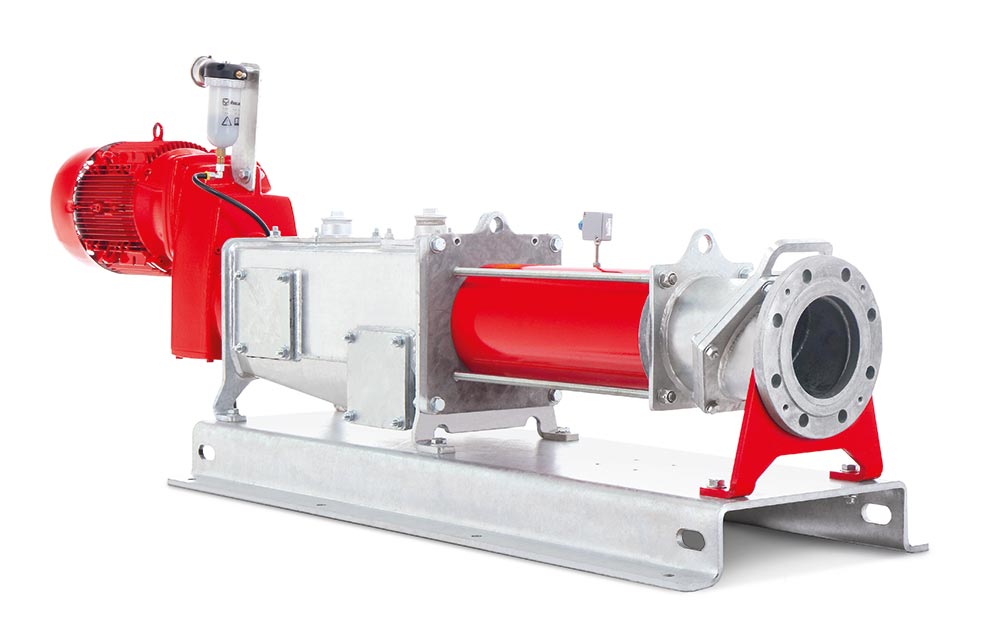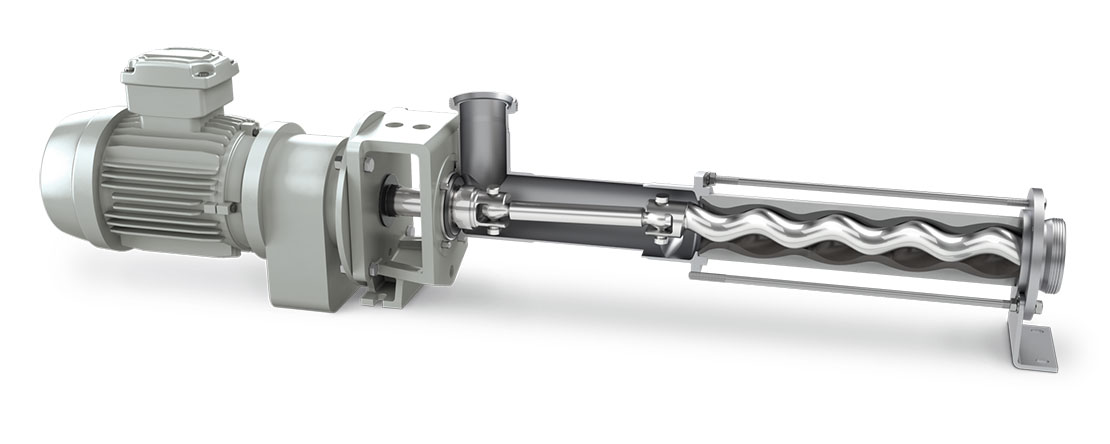High-viscosity liquids, sludge, media that contain solids – progressing cavity pumps, sometimes also called excentric screw pumps, mono pumps or moyno pumps, are the right displacement pumps for demanding fluids, also with high gas and solid contents. With their beneficial properties, progressive cavity pumps can also handle many sensitive and challenging liquids: gently, with low pulsation and precisely.
Progressing Cavity Pumps

Technical Data & Characteristics:
- Delivery rate: up to 1,000 m³/h (4,403 gpm)
- Delivery head: up to 480 m (1,575 ft)
- Pressures: 48 bar (standard) / 240 bar (high-pressure)
- Viscosities: up to 3,000,000 cSt
- Temperatures: -20 °C up to +200 °C (-4 °F up to +392 °F)
- pH-range: 0 – 14
- Gases: up to 99 %
- Solids: up to 70 % (max. 150 mm)
- Installations: horizontal, vertical
- Submersibilities: immersed
- Depth: up to 16 m (52 ft)
- self-priming (up to 9 mWS)
- API, ISO, EN standard available
- ATEX: suitable for ExZones 1 & 2
- hygienic design available
- Drives: electro, diesel, hydraulic
Progressive cavity pumps are among the rotating positive displacement pumps: That is, they handle liquids by conveying them into a conveying chamber first and then displacing them from there. The conveying movement is created by a rotating shaft (in contrast, for example to the reciprocating pump, where the piston moves in a straight line). This shaft, called the rotor, oscillates against a fixed stator. Due to the turning, spiral geometry of the two components, conveying chambers (also called cavities) are created, in which the medium flows from the pump inlet to the pump outlet. While the rotor is made of a very hard material (usually metal, for special applications also ceramic), the stator is elastic and normally made of an elastomer.
The consistency and viscosity of the fluid handled are irrelevant for the flow rate with progressing cavity pumps: The quantity transported is determined only by the speed. Combined with a frequency converter, the pump capacity can be controlled easily and precisely. The possible precision is five to three percent; small dispensers can even achieve one percent.
Funnel pumps with special screw conveyors and so-called bridge breakers are suitable for media containing large amounts of dry material. For optimal product supply, the medium is handled in a conical tamping area with a transport screw. Spoked wheels that act on the medium reliably prevent bridge formation in the pump shaft.
Because they handle liquids powerfully and gently at the same time, progressive cavity pumps can be used for many liquids for which other pumps are not recommended. They are especially suitable for the following media properties:
- abrasive
- adhesive
- aggressive (pH 0 to 14)
- contain solids (up to a grain size of approx. 150 mm) and solid-free
- low- to high-viscosity (1 mPas to 3 million mPas)
- thixotropic and dilatant
- non-lubricating and lubricating
- shear-sensitive
- toxic
Media with such properties frequently have to be handled in applications where there are strict hygiene requirements: for example in the production of foodstuffs, beverages, and liquid food or in the pharmaceutical and cosmetic sectors. For such operating environments, there are progressive cavity pumps with special hygienic designs. They comply with all relevant rules for hygienic pumps, they are dead space-free, and can be cleaned reliably (cleaning in place, CIP; and sterilization in place, SIP).
Regardless of the liquid to be handled, progressive cavity pumps provide powerful suction up to 9 mWs and quiet, low-noise running with low pulsation. Their directions of rotation and conveying can be reversed; they can be installed in any position. Operation is normally possible at temperatures from -20 °C to +200 °C.
The conveying principle of progressing cavity pumps provides several advantages:
- Continuous, low-pulsation handling of even high-viscosity liquids: The even rotation of the rotor avoids sudden pressure changes.
- Gentle handling of media with a high solid content: There are only low shear forces in the conveying space between rotor and stator.
- Great dosing precision: Depending on the speed, the pump capacity can be determined exactly for progressive cavity pumps.
- Easy reversing of the direction and conveying direction
- High suction capability even with high gas content (up to 9 mWs)
- Large free ball passage: High permissible diameter for solids prevents clogs
- Low life-cycle costs thanks to long service life and maintenance intervals

They are called progressive cavity pumps because the shaft that transfers the movement of the drive to the rotor eccentrically is shaped like a screw. Therefore, its axis does not correspond to the symmetry axis of the whole pump. Conveying is only possible thanks to this detail: Because the rotor turns against the stator, there are dense conveying spaces into which the liquid is conveyed to the pump outlet. If the drive movement were centered, that is, transferred with reference to the middle point, the rotor would no longer be able to seal against the stator, so the medium inside the pump would not be conveyed.
The progressive cavity pump is sometimes called just the eccentric screw pump. Common are also the names mono pump and moyno pump. These hark back to the name of the inventory of the progressive cavity pump: René Moineau.
In English, the term “progressive cavity pump” is used most frequently; it refers to the forward movement of the conveying spaces.


